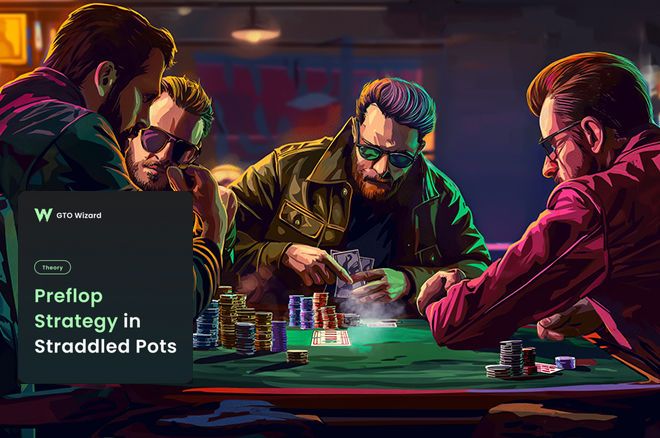The Controversy of Straddling in Poker: Is It Worth It?
Poker is a game steeped in strategy, probability, and psychological warfare. Among the many tactics players employ, the concept of straddling often ignites debate. A straddle allows a player to post a blind bet before looking at their cards, typically doubling the big blind amount. Brothers in arms with poker luminaries on shows like High Stakes Poker and Hustler Casino Live, the straddle presents both opportunities and challenges. This article dissects the mechanics of straddling, particularly from a Game Theory Optimal (GTO) perspective, drawing insights from the extensive research conducted by GTO Wizard.

What Is a Straddle?
At its core, a straddle is a voluntary blind bet that comes into play before hands are dealt. While it typically occurs under the gun (the position immediately to the left of the big blind), the size and position of a straddle can vary based on house rules. The common practice is for the straddle amount to be twice the size of the big blind. For example, in a $5/$10 cash game, the straddle would amount to $20.
The allure of straddling lies in its potential to create an action-packed game, pushing players to gamble more freely and potentially increasing the pot size preflop. However, its strategic implications demand careful consideration.
The Downsides of Straddling
GTO Wizard’s deep dive into straddling under the gun reveals that the short answer to whether straddling is worth it is a resounding no. The fundamental flaw in the straddle strategy is that it places the player at a significant positional disadvantage. When a player puts money into the pot without seeing their hole cards, they forego the opportunity to gauge their rivals’ intentions.
- Positional Disadvantage: The early position leaves the straddler exposed to players who can see their betting patterns and exploit their weak positioning.
- Reduced Expected Value (EV): Straddling results in a negative EV most of the time, as the benefits of increasing action do not compensate for the inherent risks of the positional disadvantage.
When Is Straddling a Good Idea?
Generally, the straddle move is viewed skeptically in theory-based game styles. However, GTO Wizard does highlight certain scenarios where straddling may prove beneficial:
-
Private Games for Action: In private games where players prioritize entertainment and action over strict betting strategy, occasional straddling might foster a more enjoyable environment. This approach can help keep the game lively and retain players looking for action.
- Creating a Loose Table Image: While it is not advisable to straddle merely to cultivate a loose image, under specific conditions, it might inadvertently serve that purpose.
The Impact on Stack Sizes
An under-the-gun straddle massively influences effective stack sizes. A $20 straddle in a $5/$10 game alters the perception of stack depth considerably:
-
Stack Depth and Perception: In this scenario, the big blind effectively turns into a $20 bet, meaning that a $1,000 stack is closer to 50 big blinds than the conventional 100 big blinds. This alters how players approach all-in decisions and bet sizing.
- Changing Pot Dynamics: As the straddle doubles the preflop pot size, the potential for larger risks—and thus rewards—changes dramatically. A stack that represented a secure position pre-straddle now morphs into a much higher-stakes dynamic.
Paul Magriel’s concept of "unit M" further elucidates the shifting dynamics of stack sizes in straddled pots. For players with a deeper understanding of stack-to-pot ratios, straddling offers an extended form of quantifying risk.
Adjusting Your Bankroll and Opening Ranges
Playing in games featuring regular straddles necessitates a larger bankroll. The need for a hefty sum arises due to the increased pot sizes and the inherent risks involved. Specifically, players need to understand how straddling alters opening ranges and potential betting strategies:
-
Bankroll Considerations: You’ll likely require a bankroll twice as large to maintain the same level of play as in games without straddles.
- Adjusting Open Ranges: Contrary to popular belief, players should tighten their opening ranges from earlier positions, such as the button, while accounting for the new dynamics of straddled pots. GTO Wizard suggests that players might need to open 15-20% fewer hands to combat the inflated pot sizes effectively.
Conclusion
While the allure of straddling can tempt players into thinking they’re playing a clever strategic maneuver, it often turns out to be a double-edged sword. GTO Wizard’s research highlights the pitfalls of the straddle, including positional disadvantage, altered stack sizes, and bankroll requirements, making it an unwise choice for most players. However, under rare circumstances—or in the right environment—straddling can serve as a tool to spice up the game.
Understanding the strategic implications of the straddle will greatly elevate a player’s skill set, making them a more formidable opponent at the table. Whether you choose to straddle or avoid it altogether, knowledge is your best weapon in the beloved game of poker.












